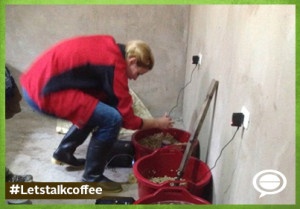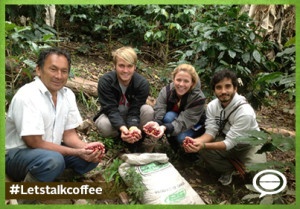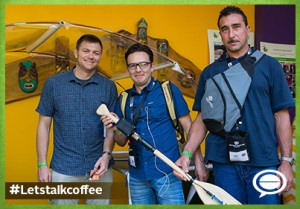 Sustainable Harvest® may be best known as a coffee importer, but the company also teams with a wide variety of partners to enact origin-based programs that benefit coffee growers. One such project currently under way is with Stanford University’s Institute of Design (d.school), and it has yielded a fermentation-monitoring tool that could make a significant impact in coffee growers’ lives.
Sustainable Harvest® may be best known as a coffee importer, but the company also teams with a wide variety of partners to enact origin-based programs that benefit coffee growers. One such project currently under way is with Stanford University’s Institute of Design (d.school), and it has yielded a fermentation-monitoring tool that could make a significant impact in coffee growers’ lives.
Fermentation is a key part of the production process in which farmers soak the coffee beans, enabling them to wash the mucilage layer off the outside before washing and subsequently drying the beans. Most farmers have a rough idea of how long to leave their coffee in the fermentation tank for best results, but it remains somewhat of a guessing game. If they remove the beans too early, they miss out on introducing flavors that could increase their cupping score. Too long, and they can introduce flavor defects.
 The new, paddle-shaped tool uses pH levels to monitor fermentation progress. The device comprises a probe and a pH monitor; when coffee is in the fermentation tank, the user places the paddle in the tank and stirs, and a buzzer sounds when the coffee reaches the ideal fermentation level.
The new, paddle-shaped tool uses pH levels to monitor fermentation progress. The device comprises a probe and a pH monitor; when coffee is in the fermentation tank, the user places the paddle in the tank and stirs, and a buzzer sounds when the coffee reaches the ideal fermentation level.
While the tool is still in the testing phase, its potential is enormous. Empowering farmers to reach the full flavor potential of their coffees by understanding the fermentation process could be an industry-changing development.
Assessing need
Sustainable Harvest® began working last year with students and staff from the Design for Extreme Affordability course at the d.school. The class focuses on generating ideas for innovative, effective and low-cost products, and students and staff employ an empathic approach to learn the users’ needs and design accordingly. To help the students get closer to coffee at the source, Sustainable Harvest® invited them to the Antioquia region of Colombia to spend several days with farmers.
 During that trip, one group of students identified fermentation as an area of coffee processing that could benefit from innovation. For farmers, the progress of fermentation isn’t easy to gauge: Over-fermented beans will negatively impact cup quality, but they’ll show no visible signs of defect before eventually turning yellow. Colombian cooperatives interviewed by the team reported that 5 to 15 percent of their beans were over-fermented—the equivalent of about 187 million pounds of coffee per year that can’t be exported, which translates to $95 million dollars of lost revenue.
During that trip, one group of students identified fermentation as an area of coffee processing that could benefit from innovation. For farmers, the progress of fermentation isn’t easy to gauge: Over-fermented beans will negatively impact cup quality, but they’ll show no visible signs of defect before eventually turning yellow. Colombian cooperatives interviewed by the team reported that 5 to 15 percent of their beans were over-fermented—the equivalent of about 187 million pounds of coffee per year that can’t be exported, which translates to $95 million dollars of lost revenue.
Crafting a solution
[vimeo id="87132341" mode="normal" align="left"]
The team set about designing a fermentation-focused tool, and soon discovered that the fermentation progress is effectively measured through pH—the measure of acidity or basicity in a substance. The pH level starts at around 6.0 in the fermentation process and dips as low as 3.0; the team says testing has so far shown that the ideal level for cup quality is between 4.0 and 4.6. After moving through two box-shaped prototypes—both featuring a wire leading to a pH-reading probe as well as a progress bar tracking pH level—the students decided the box shape was too clunky and only allowed the farmer to read pH levels in one area of the tank.
That led them to the current, paddle-shaped prototype. The pH probe sits on the wide end of the paddle with a strainer around it, allowing liquid to come through while keeping out beans that could interfere with the reading. Wires connect the probe to the box of the earlier prototype, which sits below the paddle’s handle—it reads the pH level every half second and averages those levels over time. The team says many farmers already use sticks or paddles to circulate their beans in the fermentation tank, so the device fits naturally with their routine and allows them to read pH in all areas of the tank.
Imminent impact
 The students have moved on from the Design for Extreme Affordability course and have formed a new organization, C.Lab, focused on innovations for the small farmer. C.Lab is slated to begin production of the fermentation-monitoring tool early this year and will launch a pilot program involving 100 to 200 small-scale farmers to test the devices. Sustainable Harvest® will be working closely with C.Lab to launch the fermentation pilot program and conduct controlled testing of these products.
The students have moved on from the Design for Extreme Affordability course and have formed a new organization, C.Lab, focused on innovations for the small farmer. C.Lab is slated to begin production of the fermentation-monitoring tool early this year and will launch a pilot program involving 100 to 200 small-scale farmers to test the devices. Sustainable Harvest® will be working closely with C.Lab to launch the fermentation pilot program and conduct controlled testing of these products.
While the tool’s potential impact on cup quality is exciting, what’s perhaps even more intriguing is the notion that coffee processing can be made better. No steps are set in stone, and by introducing unique ideas at the ground level, vast improvements can be made. Sustainable Harvest is excited to be working on this innovative project and working toward a stronger, more efficient supply chain.
To find out more information on C.Lab’s progress, visit its blog here.



.png)
